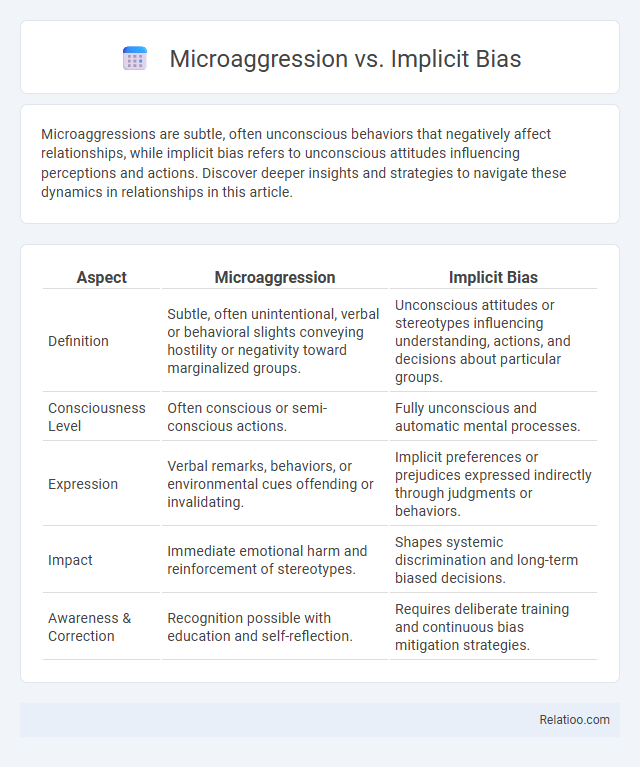Microaggressions are subtle, often unconscious behaviors that negatively affect relationships, while implicit bias refers to unconscious attitudes influencing perceptions and actions. Discover deeper insights and strategies to navigate these dynamics in relationships in this article.
Table of Comparison
| Aspect | Microaggression | Implicit Bias |
|---|---|---|
| Definition | Subtle, often unintentional, verbal or behavioral slights conveying hostility or negativity toward marginalized groups. | Unconscious attitudes or stereotypes influencing understanding, actions, and decisions about particular groups. |
| Consciousness Level | Often conscious or semi-conscious actions. | Fully unconscious and automatic mental processes. |
| Expression | Verbal remarks, behaviors, or environmental cues offending or invalidating. | Implicit preferences or prejudices expressed indirectly through judgments or behaviors. |
| Impact | Immediate emotional harm and reinforcement of stereotypes. | Shapes systemic discrimination and long-term biased decisions. |
| Awareness & Correction | Recognition possible with education and self-reflection. | Requires deliberate training and continuous bias mitigation strategies. |
Understanding Microaggressions: Definition and Examples
Microaggressions are subtle, often unintentional behaviors or comments that convey prejudiced attitudes toward marginalized groups, distinct from implicit bias, which refers to unconscious associations or stereotypes influencing actions. Examples of microaggressions include repeatedly mispronouncing a person's name, making assumptions about someone's abilities based on their race or gender, or dismissing experiences of discrimination. Understanding these nuances helps you recognize how microaggressions impact social interactions and perpetuate inequality.
What Is Implicit Bias? Unconscious Attitudes Explained
Implicit bias refers to the unconscious attitudes or stereotypes that affect understanding, actions, and decisions in an involuntary manner. It contrasts with microaggressions, which are subtle, often unintentional, discriminatory comments or behaviors reflecting those underlying biases. Understanding implicit bias involves recognizing how these hidden prejudices influence social interactions and contribute to systemic inequality.
Key Differences Between Microaggressions and Implicit Bias
Microaggressions refer to subtle, often unintentional, verbal or behavioral slights that convey negative messages toward marginalized groups, while implicit bias encompasses unconscious attitudes or stereotypes influencing perceptions and actions. The key difference lies in manifestation: microaggressions are specific actions or statements, whereas implicit bias represents underlying cognitive processes shaping those behaviors. Understanding this distinction is crucial for addressing the impact of both in social interactions and organizational diversity initiatives.
Origins and Causes of Microaggressions
Microaggressions stem from unconscious attitudes and stereotypes embedded in social and cultural environments, often influenced by implicit bias--the automatic, unintentional associations your brain forms about different social groups. Implicit biases develop through lifelong exposure to societal norms, media portrayals, and personal experiences, which then manifest as microaggressions in everyday interactions. Understanding these origins helps you recognize how deep-seated prejudices perpetuate subtle, often unnoticed forms of discrimination.
How Implicit Bias Manifests in Everyday Life
Implicit bias manifests in everyday life through unconscious attitudes and stereotypes that influence your perceptions, judgments, and actions without your awareness. These biases can lead to microaggressions, subtle and often unintentional comments or behaviors that convey negative or prejudiced messages to marginalized groups. Recognizing and addressing implicit bias is essential to reduce these microaggressions and promote more equitable interactions in personal and professional settings.
The Impact of Microaggressions on Mental Health
Microaggressions, subtle and often unintentional discriminatory comments or behaviors, can significantly affect Your mental health by causing stress, anxiety, and feelings of isolation. Unlike implicit bias, which refers to unconscious attitudes influencing behavior, microaggressions directly manifest in everyday interactions, amplifying negative emotional responses. Understanding and addressing these microaggressions is crucial for fostering inclusive environments and promoting psychological well-being.
Recognizing Implicit Bias Within Ourselves
Recognizing implicit bias within ourselves involves understanding the unconscious attitudes and stereotypes that influence our perceptions and actions without our awareness. Microaggressions, which are subtle, often unintentional comments or behaviors, stem from these implicit biases and can marginalize others. By identifying and addressing your implicit biases, you can reduce microaggressions and foster a more inclusive environment.
Strategies to Address and Reduce Microaggressions
Strategies to address and reduce microaggressions involve raising awareness through comprehensive diversity training programs that highlight the impact of language and behavior on marginalized groups. Implementing organizational policies that promote inclusivity, encourage open dialogue, and establish clear reporting mechanisms helps create environments where implicit bias and microaggressions are acknowledged and challenged. Regular assessment and feedback systems facilitate ongoing education and cultural competence development, reducing the frequency and harm of subtle discriminatory actions.
Combating Implicit Bias: Practical Steps for Change
Combating implicit bias requires actively recognizing unconscious stereotypes and implementing structured training programs that promote self-awareness and empathy. Practical steps include regular bias assessments, diverse hiring practices, and creating inclusive environments that encourage open dialogue and reflection. Consistent reinforcement of these practices fosters meaningful behavioral change and reduces the impact of hidden prejudices in organizational settings.
Building Inclusive Environments: Moving Beyond Awareness
Building inclusive environments requires recognizing the nuanced differences between microaggressions, implicit bias, and stereotypes, as each impacts workplace culture uniquely. Microaggressions are subtle, often unintentional, discriminatory comments or actions that undermine marginalized groups, while implicit biases are unconscious attitudes influencing behavior without deliberate intent. To create lasting change, your initiatives must move beyond mere awareness by implementing targeted training and organizational policies that actively challenge and reduce these behaviors and biases.

Infographic: Microaggression vs Implicit Bias
 relatioo.com
relatioo.com